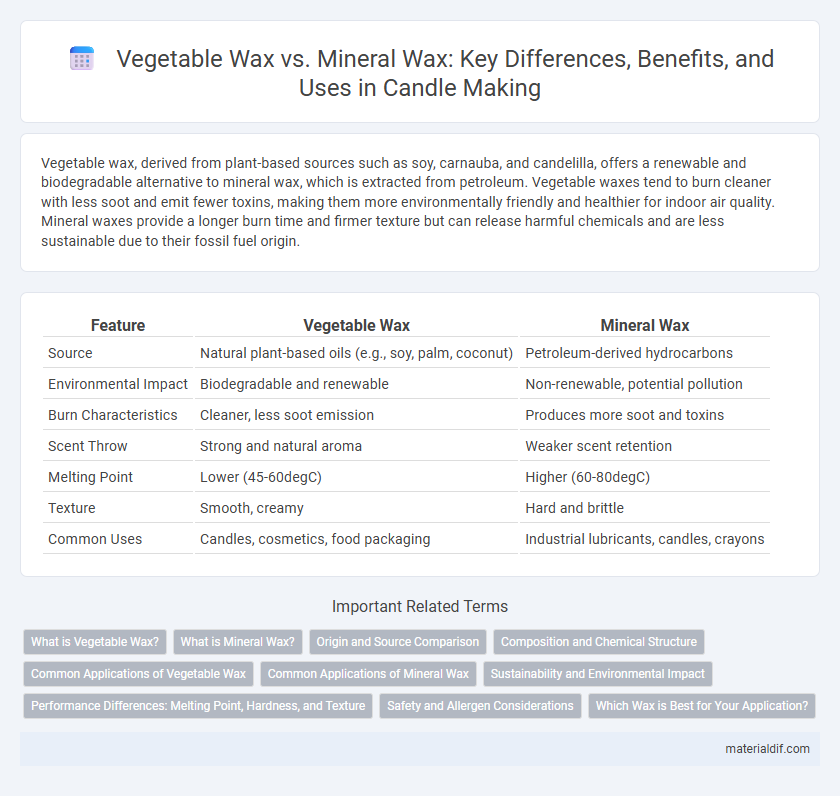Vegetable wax, derived from plant-based sources such as soy, carnauba, and candelilla, offers a renewable and biodegradable alternative to mineral wax, which is extracted from petroleum. Vegetable waxes tend to burn cleaner with less soot and emit fewer toxins, making them more environmentally friendly and healthier for indoor air quality. Mineral waxes provide a longer burn time and firmer texture but can release harmful chemicals and are less sustainable due to their fossil fuel origin.
Table of Comparison
| Feature | Vegetable Wax | Mineral Wax |
|---|---|---|
| Source | Natural plant-based oils (e.g., soy, palm, coconut) | Petroleum-derived hydrocarbons |
| Environmental Impact | Biodegradable and renewable | Non-renewable, potential pollution |
| Burn Characteristics | Cleaner, less soot emission | Produces more soot and toxins |
| Scent Throw | Strong and natural aroma | Weaker scent retention |
| Melting Point | Lower (45-60degC) | Higher (60-80degC) |
| Texture | Smooth, creamy | Hard and brittle |
| Common Uses | Candles, cosmetics, food packaging | Industrial lubricants, candles, crayons |
What is Vegetable Wax?
Vegetable wax is a natural, biodegradable substance derived from plant sources such as soybeans, palm, and candelilla. It is widely used in cosmetics, candles, and food coatings due to its sustainability, non-toxicity, and renewable origin. Unlike mineral wax, which comes from petroleum, vegetable wax offers an eco-friendly alternative with a lower environmental impact.
What is Mineral Wax?
Mineral wax is a petroleum-derived substance obtained through the refining of crude oil, commonly used in candles, cosmetics, and industrial applications due to its hardness and high melting point. Unlike vegetable wax, which is plant-based and biodegradable, mineral wax is non-renewable and less environmentally friendly. Its chemical stability and moisture resistance make it ideal for products requiring durability and longevity.
Origin and Source Comparison
Vegetable wax originates from plant-based sources such as soybeans, coconut, and palm, making it a renewable and biodegradable option that supports sustainable agriculture. Mineral wax, primarily derived from petroleum refining processes, is non-renewable and associated with environmental concerns related to fossil fuel extraction. The key distinction lies in vegetable wax's natural, eco-friendly origin versus mineral wax's synthetic, petroleum-based source.
Composition and Chemical Structure
Vegetable wax is composed primarily of long-chain fatty acids and alcohols derived from plants, exhibiting an ester-based chemical structure that contributes to its biodegradability and renewable nature. Mineral wax, commonly known as paraffin wax, is a petroleum byproduct consisting of saturated hydrocarbons with a straight or branched chain structure, leading to a non-renewable and less environmentally friendly profile. The fundamental difference in chemical composition influences melting points, solubility, and applications in cosmetics, candles, and coatings.
Common Applications of Vegetable Wax
Vegetable wax, derived from natural plant sources like soy, carnauba, and candelilla, is widely used in candle making, cosmetics, and food packaging due to its eco-friendly and biodegradable properties. Its ability to blend well with fragrances and essential oils makes it a popular choice for scented candles and skincare products. Unlike mineral wax, which originates from petroleum, vegetable wax offers a renewable alternative favored in sustainable and organic applications.
Common Applications of Mineral Wax
Mineral wax, derived from petroleum byproducts, is widely used in applications such as candle making, cosmetics, and polishes due to its hardness and high melting point. Its water-resistant properties make it ideal for waterproof coatings and inks in printing industries. The chemical stability and smooth texture of mineral wax also contribute to its use in pharmaceuticals and food packaging.
Sustainability and Environmental Impact
Vegetable wax, derived from renewable plant sources like soy or palm, offers greater sustainability due to its biodegradability and lower carbon footprint compared to mineral wax, which is petroleum-based and non-renewable. The production of mineral wax contributes to environmental degradation through fossil fuel extraction and emits higher greenhouse gases during refining. Opting for vegetable wax reduces dependence on fossil fuels and supports eco-friendly practices in candle making and cosmetics.
Performance Differences: Melting Point, Hardness, and Texture
Vegetable waxes typically have a lower melting point, ranging between 40 to 60degC, offering a softer texture compared to mineral waxes which melt around 60 to 80degC and provide greater hardness. The hardness of mineral waxes like paraffin ensures durability and resistance to deformation, while vegetable waxes such as soy or palm wax deliver a smoother, creamier finish ideal for cosmetics and candles. Texture differences influence application performance, with vegetable waxes promoting better blendability and mineral waxes enhancing structural integrity.
Safety and Allergen Considerations
Vegetable waxes, derived from plant sources like soy or palm, tend to be hypoallergenic and safer for skin applications, reducing the risk of irritations or allergic reactions compared to mineral waxes. Mineral waxes, sourced from petroleum, may contain impurities that can trigger sensitivities or exacerbate skin allergies in some individuals. Choosing vegetable wax enhances safety profiles for cosmetics and candles, offering a more natural and skin-friendly alternative.
Which Wax is Best for Your Application?
Vegetable wax, derived from renewable plant sources like soy and palm, offers biodegradability and a cleaner burn, making it ideal for eco-friendly candles and skincare products. Mineral wax, primarily made from petroleum byproducts such as paraffin, provides a harder texture and longer shelf life, preferred for industrial applications and high-performance coatings. Selecting the best wax depends on factors like environmental impact, intended use, and desired physical properties, with vegetable wax favored for sustainable options and mineral wax chosen for durability and cost-effectiveness.
Vegetable Wax vs Mineral Wax Infographic

 materialdif.com
materialdif.com